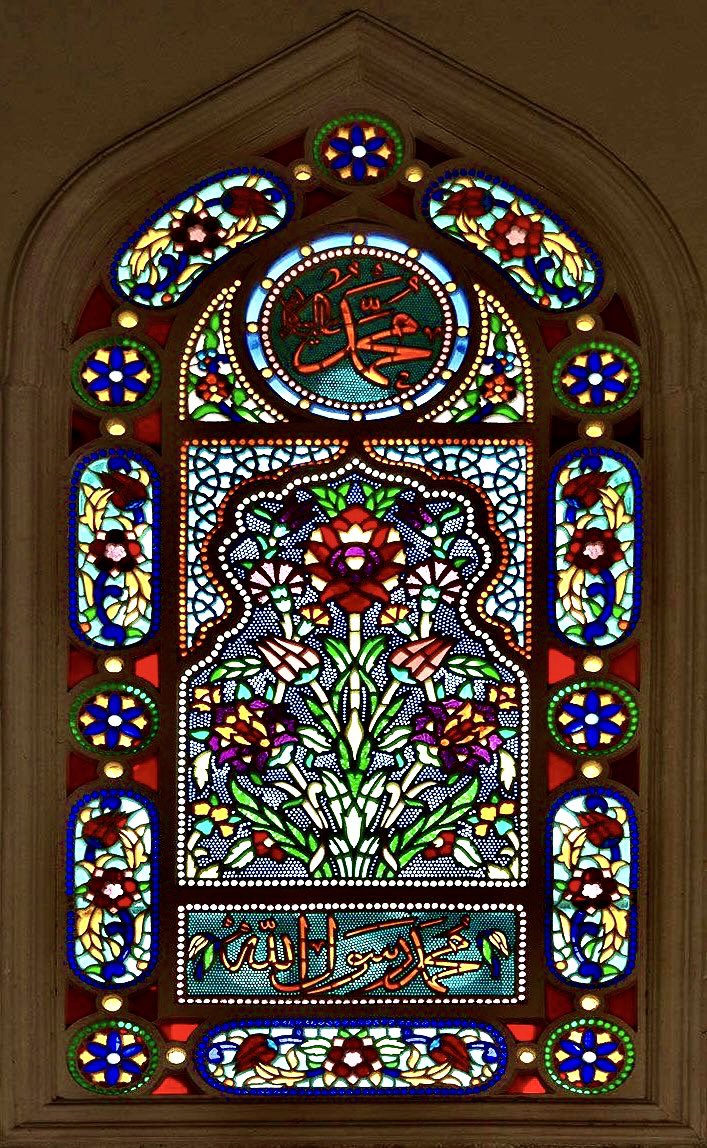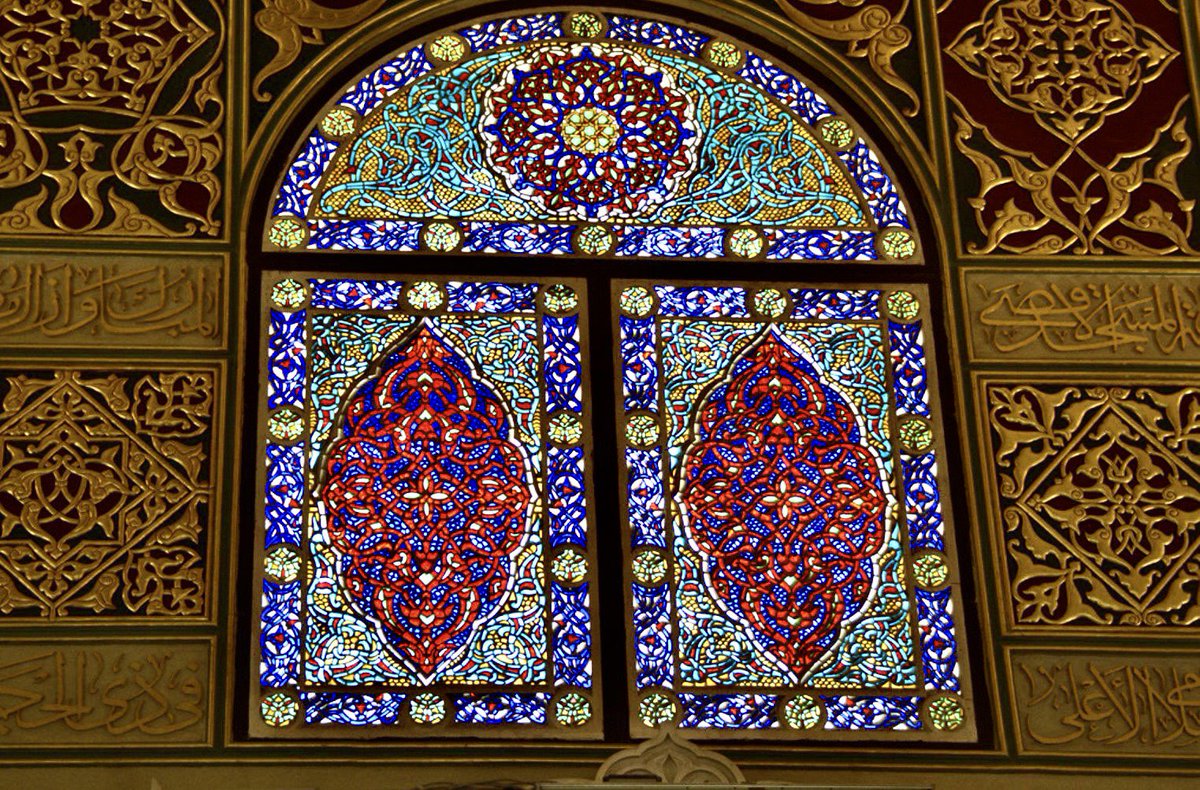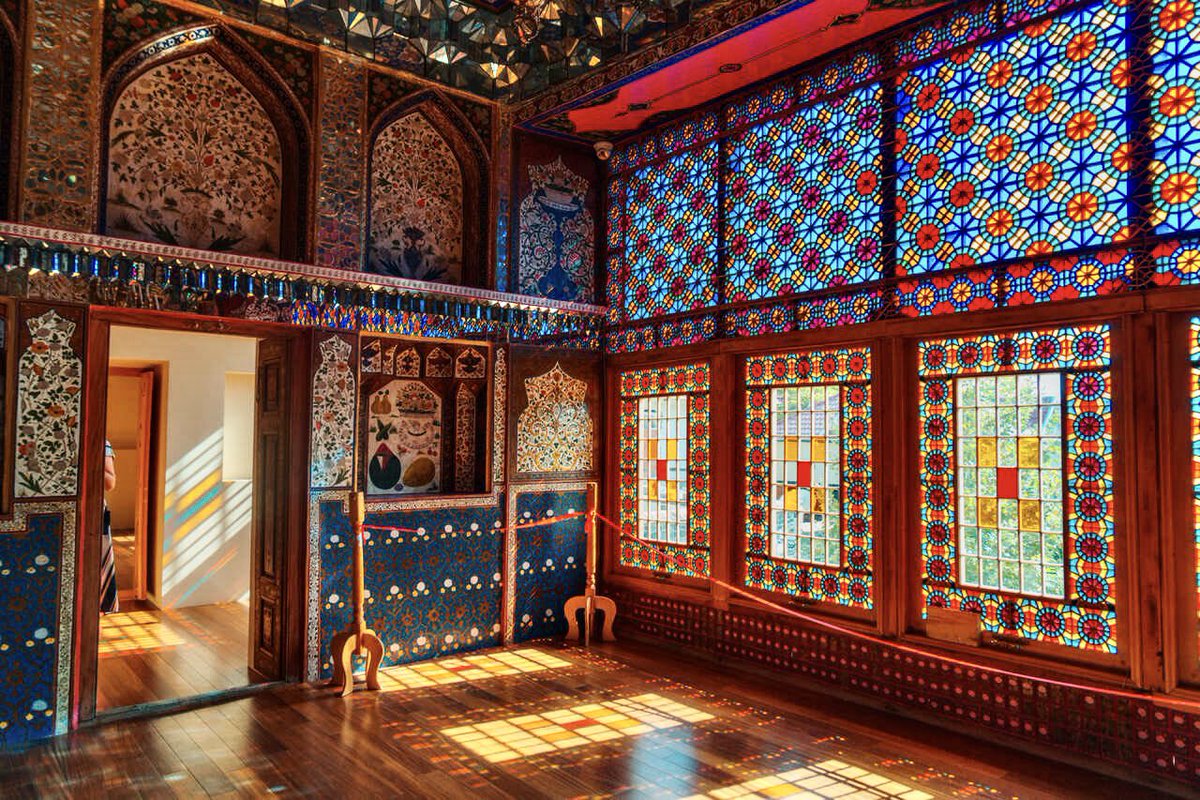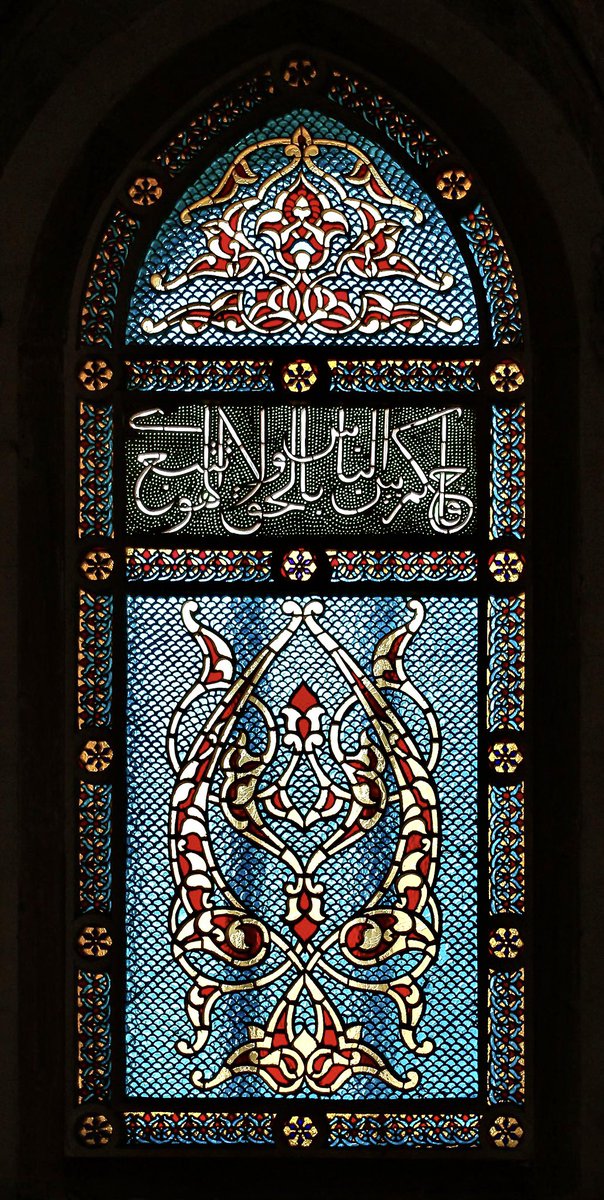Stained glass has been used by artisans across the globe for thousands of years. Since the 8th century, the Muslim world played a major role in the growth of the glass industry. Mosques & cities were transformed into beautiful spaces richly decorated with glass.
A thread…
A thread…

1/ Stained glass window at The Şemsi Pasha Mosque, Turkey
Designed by Ottoman imperial architect Mimar Sinan in 1581 for Grand Vizier Şemsi Pasha. It is one of the most attractive mosques in the city & a celebrated example of the chief architect's skills.
Designed by Ottoman imperial architect Mimar Sinan in 1581 for Grand Vizier Şemsi Pasha. It is one of the most attractive mosques in the city & a celebrated example of the chief architect's skills.

2/ Stained glass window at Beit Al Qur'an, Hoora, Bahrain
A multi-purpose complex dedicated to the Islamic arts. Established in 1990, the complex is most famous for its Islamic museum, which has been acknowledged as being one of the most renowned Islamic museums in the world.
A multi-purpose complex dedicated to the Islamic arts. Established in 1990, the complex is most famous for its Islamic museum, which has been acknowledged as being one of the most renowned Islamic museums in the world.

3/ Stained glass windows at The Nasir al-Mulk Mosque, Iran
Constructed between 1876 & 1888, during the Qajar dynasty, which ruled Iran from 1785 to 1925. It has been dubbed the “Pink Mosque” due to the plethora of pink-colored tiles blanketing the ceiling
Constructed between 1876 & 1888, during the Qajar dynasty, which ruled Iran from 1785 to 1925. It has been dubbed the “Pink Mosque” due to the plethora of pink-colored tiles blanketing the ceiling

5/ Stained glass window at the Mosque-Cathedral of Cordoba, Spain
It represents a unique artistic achievement due to its size height of its ceilings. It is an irreplaceable testimony of the Caliphate of Cordoba & is the most emblematic monument of Islamic religious architecture
It represents a unique artistic achievement due to its size height of its ceilings. It is an irreplaceable testimony of the Caliphate of Cordoba & is the most emblematic monument of Islamic religious architecture

6/ Stained glass windows at Dowlatabad Garden, Yazd, Iran
Created in 1747 by Mohammad Taghi Khan Bafqi. It was listed as a UNESCO world heritage site in 2011, as part of the Persian gardens. It is also listed in UNESCO as a part of the historical city of Yazd in 2017.
Created in 1747 by Mohammad Taghi Khan Bafqi. It was listed as a UNESCO world heritage site in 2011, as part of the Persian gardens. It is also listed in UNESCO as a part of the historical city of Yazd in 2017.

7/ Stained glass window at The Sultan Qaboos Grand Mosque, Oman
In 1992, Qaboos bin Said al Said, the then Sultan of Oman, directed that his country should have a Grand Mosque. A competition for its design took place in 1993 it took 6 years and 7 months to complete.
In 1992, Qaboos bin Said al Said, the then Sultan of Oman, directed that his country should have a Grand Mosque. A competition for its design took place in 1993 it took 6 years and 7 months to complete.

8/ Stained glass windows at Bibi-Eybat Mosque, Baku, Azerbaijan
The existing structure built in the 1990s is a recreation of the mosque with the same name built in the 13th century by Shirvanshah Farrukhzad II Ibn Ahsitan II, which was destroyed by the Bolsheviks in 1936.
The existing structure built in the 1990s is a recreation of the mosque with the same name built in the 13th century by Shirvanshah Farrukhzad II Ibn Ahsitan II, which was destroyed by the Bolsheviks in 1936.

9/ Stained glass window at Selimiye mosque, Edirne, Turkey
Commissioned by Sultan Selim II, & was built by the imperial architect Mimar Sinan between 1568 & 1575. It was considered by Sinan to be his masterpiece & one of the highest achievements of Islamic architecture.
Commissioned by Sultan Selim II, & was built by the imperial architect Mimar Sinan between 1568 & 1575. It was considered by Sinan to be his masterpiece & one of the highest achievements of Islamic architecture.

10/ Stained glass window at Umayyad Mosque, Syria
One of the largest & oldest mosques in the world. Christian & Muslim tradition alike consider it the burial place of John the Baptist, a tradition originating in the 6th century.
One of the largest & oldest mosques in the world. Christian & Muslim tradition alike consider it the burial place of John the Baptist, a tradition originating in the 6th century.

11/ Stained glass windows at Grand Çamlıca Mosque, Turkey
Currently the largest mosque in Turkey, it was completed and opened on 7 March 2019. The mosque stands astride Çamlıca Hill in the Üsküdar district of Istanbul and is visible from much of the centre of the city.
Currently the largest mosque in Turkey, it was completed and opened on 7 March 2019. The mosque stands astride Çamlıca Hill in the Üsküdar district of Istanbul and is visible from much of the centre of the city.

12/ Stained glass window at Sultan Omar Ali Saifuddien Mosque, Brunei
Considered one of the most beautiful mosques in the Asia Pacific. Construction of the mosque was completed
on 26 September 1958. It is named after Omar Ali Saifuddin III, the 28th Sultan of Brunei Darussalam
Considered one of the most beautiful mosques in the Asia Pacific. Construction of the mosque was completed
on 26 September 1958. It is named after Omar Ali Saifuddin III, the 28th Sultan of Brunei Darussalam

13/ Stained glass window at Kul Sharif Mosque, Kazan
Built in the 16th century, it was named after Kul Sharif, who was a religious scholar who served there. Kul Sharif died with his numerous students while defending Kazan from Russian forces in 1552.
Built in the 16th century, it was named after Kul Sharif, who was a religious scholar who served there. Kul Sharif died with his numerous students while defending Kazan from Russian forces in 1552.

14/ Stained glass window at Al-Aqsa Mosque, Jerusalem, Palestine
In the Old City of Jerusalem the 3rd holiest site in Islam. It was built on top of the Temple Mount, known as the Al Aqsa Compound or Haram esh-Sharif in Islam, several decades after Prophet Muhammad's (PBUH) death
In the Old City of Jerusalem the 3rd holiest site in Islam. It was built on top of the Temple Mount, known as the Al Aqsa Compound or Haram esh-Sharif in Islam, several decades after Prophet Muhammad's (PBUH) death

15/ Stained glass windows at Sultan Ahmed Mosque, Turkey
An Ottoman-era historical imperial mosque, it attracts large numbers of tourist visitors. It was constructed between 1609 and 1616 during the rule of Ahmed I. Its Külliye contains Ahmed's tomb, a madrasah and a hospice.
An Ottoman-era historical imperial mosque, it attracts large numbers of tourist visitors. It was constructed between 1609 and 1616 during the rule of Ahmed I. Its Külliye contains Ahmed's tomb, a madrasah and a hospice.

16/ Stained glass window at Darül Kurra, Turkey
Built in 1492 by Hodja Yakup. This “darulkurra”, a place where the Holy Qur’an was taught, is also known as “Hodja Yakup Darulkurra” or “Yer Kapı Muallimhanesi”.
Built in 1492 by Hodja Yakup. This “darulkurra”, a place where the Holy Qur’an was taught, is also known as “Hodja Yakup Darulkurra” or “Yer Kapı Muallimhanesi”.

17/ Stained glass window at Sheikh Zayed Grand Mosque, Abu Dhabi, UAE
The largest mosque in the country, it is the key place of worship for daily prayers. Built between 1994 and 2007, the project was launched by the late president of the UAE Sheikh Zayed bin Sultan Al Nahyan.
The largest mosque in the country, it is the key place of worship for daily prayers. Built between 1994 and 2007, the project was launched by the late president of the UAE Sheikh Zayed bin Sultan Al Nahyan.

18/ Stained glass windows at Sheesh Mahal, Kot Diji, Sindh, Pakistan
Built by Mir Fateh Ali Khan, who established the Talpur dynasty. Talpur architecture features a combination of various elements that have roots derived from Islamic, Mughal, Rajasthani & British buildings.
Built by Mir Fateh Ali Khan, who established the Talpur dynasty. Talpur architecture features a combination of various elements that have roots derived from Islamic, Mughal, Rajasthani & British buildings.

19/ Stained glass window at Al-Aqsa Mosque, Jerusalem, Palestine
In the Old City of Jerusalem the 3rd holiest site in Islam. It was built on top of the Temple Mount, known as the Al Aqsa Compound or Haram esh-Sharif in Islam, several decades after Prophet Muhammad's (PBUH) death
In the Old City of Jerusalem the 3rd holiest site in Islam. It was built on top of the Temple Mount, known as the Al Aqsa Compound or Haram esh-Sharif in Islam, several decades after Prophet Muhammad's (PBUH) death

20/ Stained glass windows at the Khan's Palace of Shaki, Azerbaijan
Built in 1797 by Muhammed Hasan Khan. It was intended to house the Khans who were in charge of Shaki, as viceroys of the ruling Zand & later Qajar Persian dynasties from 1750 - 1813 after the Russo-Persian War.
Built in 1797 by Muhammed Hasan Khan. It was intended to house the Khans who were in charge of Shaki, as viceroys of the ruling Zand & later Qajar Persian dynasties from 1750 - 1813 after the Russo-Persian War.

21/ Stained glass window at Hagia Sophia, Turkey
Hagia Sophia was built in 537, with minarets added in the 15th–16th centuries when it became a mosque. After the Fall of Constantinople to the Ottoman Empire in 1453, it was converted to a mosque by Mehmed the Conqueror
Hagia Sophia was built in 537, with minarets added in the 15th–16th centuries when it became a mosque. After the Fall of Constantinople to the Ottoman Empire in 1453, it was converted to a mosque by Mehmed the Conqueror

22/ Stained glass window at Mosque-Cathedral of Córdoba, Spain
The original structure was built by the Umayyad ruler ʿAbd ar-Raḥmān I in 784–786 with extensions in the 9th & 10th centuries that doubled its size, making it one of the largest sacred buildings in the Islamic world
The original structure was built by the Umayyad ruler ʿAbd ar-Raḥmān I in 784–786 with extensions in the 9th & 10th centuries that doubled its size, making it one of the largest sacred buildings in the Islamic world

23/ Stained glass window at Fez Mosque, Morocco
The historic main Friday mosque of Fes el-Jdid, the royal city and Marinid-era citadel of Fes, Morocco. It was founded in 1276, around the same time that the city itself was founded, making it the oldest mosque in Fes el-Jdid.
The historic main Friday mosque of Fes el-Jdid, the royal city and Marinid-era citadel of Fes, Morocco. It was founded in 1276, around the same time that the city itself was founded, making it the oldest mosque in Fes el-Jdid.

24/ Stained glass windows at Sheki Khan’s Winter Palace, Azerbaijan
Wander through the historic city of Sheki, a UNESCO World Heritage Site, to find the Sheki Khan’s Winter Palace. The 18th-century structure & its gorgeous stained glass are sure to leave you impressed.
Wander through the historic city of Sheki, a UNESCO World Heritage Site, to find the Sheki Khan’s Winter Palace. The 18th-century structure & its gorgeous stained glass are sure to leave you impressed.

Discover more about stained glass and Muslim culture, with sources of inspiration & information for this thread - and further reading:
baytalfann.com/post/stained-g…
baytalfann.com/post/stained-g…
• • •
Missing some Tweet in this thread? You can try to
force a refresh























